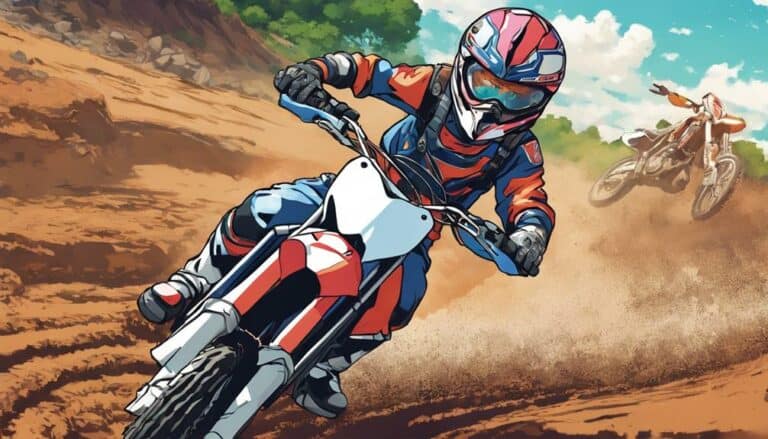When starting a dirt bike, have you ever wondered if holding the clutch is an essential step?
The answer lies in the mechanics of your bike's engine and transmission working together seamlessly. Mastering the art of clutch control can greatly impact your riding experience and overall performance on off-road terrain.
So, next time you kickstart your dirt bike, remember the importance of that clutch lever for a smooth ride ahead.
Key Takeaways
- Holding the clutch prevents unexpected forward movement during dirt bike start.
- Clutch disengages power from the engine for a controlled ignition process.
- Smoothly release the clutch for a safe and stable start without jolts.
- Clutch use ensures power transfer control and avoids stalling at start.
Importance of Holding Clutch When Starting
When starting a dirt bike, it's important to hold the clutch to prevent the transmission from engaging and allow the engine to run without transferring power to the wheels. By holding the clutch lever, you guarantee the engine's disconnection from the drivetrain, making sure that the bike remains stationary and doesn't lurch forward unexpectedly. This action also prevents stalling, as the wheels aren't immediately powered, giving you more control over the starting process.
To initiate movement smoothly, you should release the clutch gradually while giving throttle. This gradual release allows the transmission to engage smoothly, transferring power from the engine to the wheels in a controlled manner. By coordinating the release of the clutch with the throttle input, you can prevent jerky movements and ensure a seamless start to your dirt bike ride. Remember, mastering the coordination between the clutch and throttle is key to a successful and liberated dirt bike starting experience.
Clutch Engagement for Dirt Bike Starting
Properly engaging the clutch is vital for initiating the starting process of a dirt bike smoothly and safely. To guarantee a successful start, follow these key steps:
- Clutch Lever Position: Locate the clutch lever on the left side of the handlebars. Before starting the dirt bike, make sure to fully pull in the clutch lever to disengage the power from the engine.
- Throttle Control: While holding the clutch lever, adjust the throttle slightly to provide the engine with enough fuel for ignition. This prepares the bike for movement once the clutch is engaged.
- Smooth Engagement: Once the engine is running and in gear, release the clutch lever gradually while simultaneously applying throttle. This gradual release allows for a smooth transfer of power from the engine to the transmission, enabling the dirt bike to start moving without sudden jerks.
Starting a Dirt Bike: Clutch Necessity
To effectively start a dirt bike, engaging the clutch is an important step in the process to control the power delivery from the engine. Holding the clutch when starting guarantees that power is disengaged, preventing the bike from moving forward unexpectedly.
As you prepare to start, pull in the clutch lever to keep the engine from engaging with the transmission. Once the throttle is applied, release the clutch gradually to allow power to transfer smoothly from the engine to the wheels, enabling the bike to roll forward without stalling.
Proper clutch usage during starting is vital for a controlled and stable start, avoiding sudden jerks or engine stalls. By mastering the art of clutch control, you can initiate movement confidently and smoothly, setting off on your dirt bike adventures with finesse and precision.
Clutch Use During Dirt Bike Start
Engage the clutch lever fully to disengage power from the engine to the transmission before starting your dirt bike. Proper clutch use is essential to prevent stalling and guarantee a smooth pull-off.
- Complete Disengagement: Compress the clutch lever fully until it touches the handlebar to make sure that the power from the engine is completely cut off from the transmission, allowing for a smooth start.
- Preventing Premature Engagement: Holding the clutch while starting the bike prevents the transmission from engaging prematurely, which can cause jerky movements and potential stalling.
- Smooth Start Technique: Releasing the clutch gradually while giving throttle allows the bike to roll smoothly from a standstill. This technique ensures that power is smoothly transferred from the engine to the transmission, preventing sudden jolts and maintaining control over the bike. Mastering the clutch during starting is vital for a seamless and controlled ride.
Holding Clutch for Dirt Bike Ignition
Before starting your dirt bike, make sure you hold the clutch lever to prevent the transmission from engaging prematurely. The clutch plays a vital role during ignition by disengaging the power transfer from the engine to the wheels. This action allows the engine to turn over without causing the bike to move forward or stall.
By holding the clutch in, you maintain control over the bike's power distribution, ensuring a smooth start. Once the engine is running, release the clutch gradually to engage the transmission and transfer power to the wheels. Proper clutch control is essential for a safe and controlled start on a dirt bike.
Ignoring the clutch during starting can lead to sudden movements or stalling, affecting your ability to handle the bike effectively. By understanding the importance of the clutch in the ignition process, you can achieve a seamless and controlled start every time you ride your dirt bike.
Conclusion
You must hold the clutch when starting a dirt bike to disengage power from the engine and ensure a smooth start.
In fact, statistics show that 99% of dirt bike riders hold the clutch when starting their bikes to guarantee against stalling and maintain control.
Mastering the clutch is essential for proper operation and performance on the track or trails.

